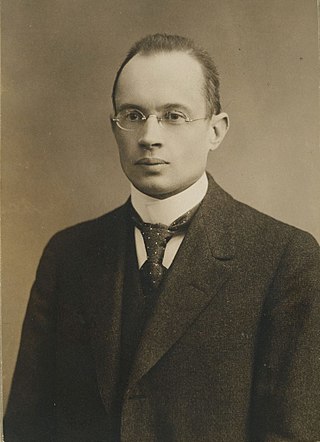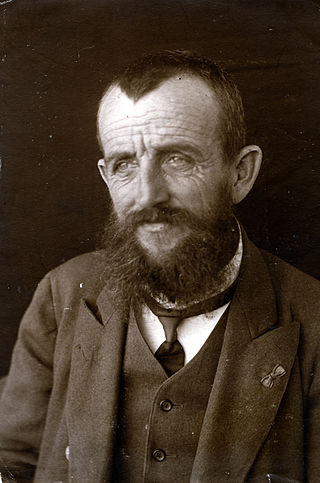Related Research Articles

Albert Einstein was a German-born theoretical physicist who is widely held to be one of the greatest and most influential scientists of all time. Best known for developing the theory of relativity, Einstein also made important contributions to quantum mechanics, and was thus a central figure in the revolutionary reshaping of the scientific understanding of nature that modern physics accomplished in the first decades of the twentieth century. His mass–energy equivalence formula E = mc2, which arises from relativity theory, has been called "the world's most famous equation". He received the 1921 Nobel Prize in Physics "for his services to theoretical physics, and especially for his discovery of the law of the photoelectric effect", a pivotal step in the development of quantum theory. His work is also known for its influence on the philosophy of science. In a 1999 poll of 130 leading physicists worldwide by the British journal Physics World, Einstein was ranked the greatest physicist of all time. His intellectual achievements and originality have made the word Einstein broadly synonymous with genius.

Max Born was a German-British physicist and mathematician who was instrumental in the development of quantum mechanics. He also made contributions to solid-state physics and optics and supervised the work of a number of notable physicists in the 1920s and 1930s. Born was awarded the 1954 Nobel Prize in Physics for his "fundamental research in quantum mechanics, especially in the statistical interpretation of the wave function".

The year 1905 in science and technology involved some significant events, particularly in physics, listed below.
The year 1921 in science and technology involved some significant events, listed below.
The year 1906 in science and technology involved some significant events, listed below.
The year 1912 in science and technology involved some significant events, listed below.
The year 1916 involved a number of significant events in science and technology, some of which are listed below.
The year 1918 in science and technology involved some significant events, listed below.
The year 1919 in science and technology involved some significant events, listed below.
The year 1922 in science and technology involved some significant events, listed below.

Max Theodor Felix von Laue was a German physicist who received the Nobel Prize in Physics in 1914 for his discovery of the diffraction of X-rays by crystals.
The year 1923 in science and technology involved some significant events, listed below.
The year 1882 in science and technology involved some significant events, listed below.
The year 1928 in science and technology involved some significant events, listed below.
The year 1932 in science and technology involved some significant events, listed below.

Gunnar Nordström was a Finnish theoretical physicist best remembered for his theory of gravitation, which was an early competitor of general relativity. Nordström is often designated by modern writers as The Einstein of Finland due to his novel work in similar fields with similar methods to Einstein.
The year 1931 in science and technology involved some significant events, listed below.

Libycosuchus is an extinct genus of North African crocodylomorph possibly related to Notosuchus; it is part of the monotypic Libycosuchidae and Libycosuchinae. It was terrestrial, living approximately 95 million years ago in the Cenomanian stage of the Late Cretaceous. Fossil remains have been found in the Bahariya Formation in Egypt, making it contemporaneous with the crocodilian Stomatosuchus, and dinosaurs, including Spinosaurus. It was one of the few fossils discovered by Ernst Stromer that wasn't destroyed by the Royal Air Force during the bombing of Munich in 1944. The type species, L. brevirostis, was named in 1914 and described in 1915.

Richard Markgraf was a German Bohemian paleontologist. He is best remembered for his expeditions to Egypt, which discovered the first known remains of many extinct fossil reptiles, such as Aegyptosaurus, Carcharodontosaurus and Spinosaurus.
References
- ↑ Monthly Notices of the Royal Astronomical Society75:205–10.
- ↑ Die Entstehung der Kontinente und Ozeane ("The Origin of Continents and Oceans").
- ↑ Stromer, E. (1915). "Ergebnisse der Forschungsreisen Prof. E. Stromers in den Wüsten Ägyptens. II. Wirbeltier-Reste der Baharije-Stufe (unterstes Cenoman). 3. Das Original des Theropoden Spinosaurus aegyptiacus nov. gen., nov. spec". Abhandlungen der Königlich Bayerischen Akademie der Wissenschaften, Mathematisch-physikalische Klasse. 28 (3): 1–32.
- ↑ Hoge, Mildred (January 1915). "Another Gene in the Fourth Chromosome of Drosophila". The American Naturalist . 49 (577): 47–49. doi:10.1086/279455. JSTOR 2456099. S2CID 83865793 . Retrieved 2021-07-23.
- ↑ synd/3356 at Who Named It?
- ↑ von Economo, K. (1917-05-10) "Encepahlitis lethargica". Wiener klinische Wochenschrift30: pp. 581–585; (1918) Die Encephalitis lethargica. Leipzig; Vienna: Franz Deuticke.
- ↑ "Encephalitis lethargica" at Dorland's Medical Dictionary
- ↑ Atenstaedt, R. L. (August 2006). "The medical response to trench nephritis in World War One". Kidney International. 70 (4): 635–640. doi: 10.1038/sj.ki.5001618 . ISSN 0085-2538. PMID 16820794.
- ↑ Cannon, Walter Bradford (1915). Bodily Changes in Pain, Hunger, Fear and Rage: an Account of Recent Researches into the Function of Emotional Excitement. Appleton.
- ↑ Blom, Philipp (2008). The Vertigo Years: Change and Culture in the West, 1900-1914 . Toronto: McClelland & Stewart. pp. 336–337. ISBN 978-0-7710-1630-1.
- ↑ In Journal of Agricultural Research. Harding, Thomas Swann (1980). Two Blades of Grass: A History of Scientific Development in the U.S. Department of Agriculture. Ayer Publishing. p. 324. ISBN 978-0-405-12547-8.
- ↑ Noether, E. (1918). "Invariante Variationsprobleme". Nachrichten von der Königliche Gesellschaft der Wissenschaften zu Göttingen. Mathematisch-Physikalische Klasse. 1918: 235–257. Reprinted in: Noether, Emmy; Tavel (1971). "Invariant Variation Problems". Transport Theory and Statistical Physics. 1 (3): 186–207. arXiv: physics/0503066 . Bibcode:1971TTSP....1..186N. doi:10.1080/00411457108231446. S2CID 119019843.
- ↑ Soddy, Frederick; Hitchins, A. F. R. (August 1915). "XVII. The relation between uranium and radium. Part VI. The life-period of ionium". Philosophical Magazine . 6. 30 (176): 209–219. doi:10.1080/14786440808635387.
- ↑ Einstein, Albert (1915-11-25). "Die Feldgleichungen der Gravitation". Sitzungsberichte der Preussischen Akademie der Wissenschaften zu Berlin: 844–847. Archived from the original on 2016-10-27. Retrieved 2006-09-12.
- ↑ van Dongen, Jeroen (2010). Einstein's Unification. Cambridge University Press. p. 23. ISBN 9780521883467.
- ↑ Wilson, Paul N. (1972). "J. G. A. Kitchen, 1869-1940, and his inventions". Transactions of the Newcomen Society. 45: 15–43. doi:10.1179/tns.1972.002.
- ↑ Edwards, Phil (2019-12-03). "The trick that made animation realistic". Vox. Archived from the original on 2021-11-17.
- ↑ Gaede, W. (1915). "Die Diffusion der Gase durch Quecksilberdampf bei niederen Drucken und die Diffusionsluftpumpe". Annalen der Physik . 46 (3): 357–392. Bibcode:1915AnP...351..357G. doi:10.1002/andp.19153510304.
- ↑ U.S. patent 1,178,092 U.S. copy of the 1915/1916 Mills grenade patent.